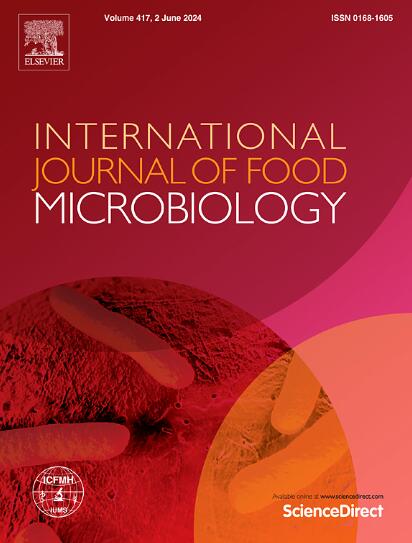常温高压贮藏枯草芽孢杆菌孢子的失活动力学及对pH和养分有效性的依赖
IF 5
1区 农林科学
Q1 FOOD SCIENCE & TECHNOLOGY
International journal of food microbiology
Pub Date : 2025-06-16
DOI:10.1016/j.ijfoodmicro.2025.111322
引用次数: 0
摘要
生的和巴氏消毒的食品可能含有细菌孢子,这代表了食品安全或腐败的威胁。在pH值高于4.6时,通常细菌孢子可以生长,暂时抑制孢子萌发和生长的最常用策略之一是冷藏(RF)。室温高压储存(HS/RT)是一种新的食品保存方法,正在研究作为射频的替代方法,特别是对于高度易腐的食品。研究了枯草芽孢杆菌芽孢杆菌孢子在pH为4.5、6.0和7.5的McIlvaine缓冲液(无营养基质)和bhi -肉汤(富营养基质)中在HS/RT (25-250 MPa)下长达30 d的行为,比较了pH和养分有效性对HS/RT下芽孢杆菌孢子行为的影响。结果表明,pH和养分有效性对高温胁迫下孢子的命运起主要作用。在pH为4.5的营养条件下和高达75 MPa的压力下,至少30天内孢子既不发育也不失活(与RF相似),但在高于150 MPa的压力下,无论基质如何,都观察到至少2.5 log单位的失活。在pH为6.0和7.5时,HS下没有发现孢子发育(25 MPa除外),并且孢子失活(特别是在pH为7.5的BHI中)至少减少了5个对数单位。对于pH为6.0和7.5的RF,孢子在BHI-broth中分别能够在5天和15天后发育,而在McIlvaine缓冲液中没有观察到变化。失活曲线在数学上由非线性动力学模型(双相、威布尔和Log-logistic)描述,尽管在少数情况下,一阶失活动力学更充分地描述了实验数据。相差显微镜显示,在pH为4.5(高达150 MPa)的所有HS条件下,大部分孢子都是亮相孢子(未萌发,活孢子),表明相当一部分孢子在30天内未萌发,而在4.5(≥200 MPa)、6.0和7.5的HS条件下,暗相孢子(萌发或死亡孢子)占主导地位,表明孢子无法完成萌发过程。这些发现表明,枯草芽孢杆菌孢子在HS/RT过程中的失活取决于营养物质的存在和基质的pH值,在不进行任何热处理的情况下,观察到至少5个对数单位的失活。不同的是,RF允许孢子在pH 6.0和7.5下萌发和生长,因此,HS/RT可能是一种有趣的新方法,可以在RT下破坏孢子,为保存易腐食品开辟新的机会。本文章由计算机程序翻译,如有差异,请以英文原文为准。
Bacillus subtilis spores' inactivation kinetics by hyperbaric storage at room temperature and dependence of pH and nutrient availability
Raw and pasteurized food products may contain bacterial spores, which represent a food safety or spoilage threat. One of the most used strategies to temporarily inhibit spore germination and outgrowth at pH values above 4.6, in which generally bacterial spores can grow, is refrigeration (RF). Hyperbaric storage at room temperatures (HS/RT) is a new food preservation methodology that is being studied as an alternative to RF, especially for highly perishable food products.
HS/RT (25–250 MPa) for up to 30 days was studied to evaluate the behaviour of Bacillus subtilis spores in McIlvaine buffer (nutrient-free matrix) and BHI-broth (nutrient-rich matrix) at three different pH levels (4.5, 6.0 and 7.5) to evaluate the effects of pH and nutrient availability on spores' behaviour under HS/RT compared with RF.
The results showed that both pH and nutrient availability play a major role in the spores' fate under HS. At pH 4.5, in both nutrient conditions and up to 75 MPa, neither spore development nor inactivation occurred for at least 30 days (similarly to RF), but this behaviour was changed at pressures above 150 MPa, where at least 2.5 log units' inactivation was observed, regardless of the matrix. At pH 6.0 and 7.5, no spore development was found under HS (except at 25 MPa), and spore inactivation (particularly in BHI at pH 7.5) with at least 5 log units' reduction was observed. For RF at pH 6.0 and 7.5, the spores were able to develop after 5 and 15 days, respectively, in BHI-broth, with no changes being observed in McIlvaine buffer. The inactivation curves were mathematically described by nonlinear kinetic models (Biphasic, Weibull and Log-logistic), despite a few cases where the first-order inactivation kinetics described the experimental data more adequately.
Phase-contrast microscopy revealed mostly bright-phase spores (ungerminated, viable spores) for all HS conditions at pH 4.5 (up to 150 MPa), indicating that a considerable fraction of spores remained ungerminated for 30 days, while at 4.5 (≥200 MPa), 6.0 and 7.5 dark-phase spores (germinating or death spores) were predominant, suggesting that the spores were unable to complete the germination process.
These findings indicate that B. subtilis spores' inactivation during HS/RT is dependent on the presence of nutrients and on the pH of the matrix, being observed an inactivation of at least 5-log units, without applying any thermal treatment. Differently, RF allowed spore germination and outgrowth at pH 6.0 and 7.5 and so, HS/RT may be an interesting new methodology to destroy spores at RT, opening novel opportunities to preserve perishable foods.
求助全文
通过发布文献求助,成功后即可免费获取论文全文。
去求助
来源期刊
CiteScore
10.40
自引率
5.60%
发文量
322
审稿时长
65 days
期刊介绍:
The International Journal of Food Microbiology publishes papers dealing with all aspects of food microbiology. Articles must present information that is novel, has high impact and interest, and is of high scientific quality. They should provide scientific or technological advancement in the specific field of interest of the journal and enhance its strong international reputation. Preliminary or confirmatory results as well as contributions not strictly related to food microbiology will not be considered for publication.

 求助内容:
求助内容: 应助结果提醒方式:
应助结果提醒方式:


